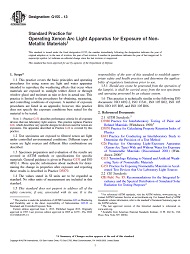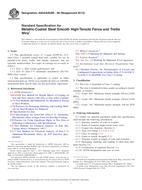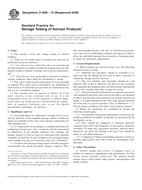1.1 These test methods cover the determination of carbon, sulfur, nitrogen, and oxygen, in steel and in iron, nickel, and cobalt alloys having chemical compositions within the following limits:
| Element | Concentration Range, % |
| Aluminum | 0.001 to 18.00 |
| Antimony | 0.002 to 0.03 |
| Arsenic | 0.0005 to 0.10 |
| Beryllium | 0.001 to 0.05 |
| Bismuth | 0.001 to 0.50 |
| Boron | 0.0005 to 1.00 |
| Cadmium | 0.001 to 0.005 |
| Calcium | 0.001 to 0.05 |
| Carbon | 0.001 to 4.50 |
| Cerium | 0.005 to 0.05 |
| Chromium | 0.005 to 35.00 |
| Cobalt | 0.01 to 75.0 |
| Columbium | 0.002 to 6.00 |
| Copper | 0.005 to 10.00 |
| Hydrogen | 0.0001 to 0.0030 |
| Iron | 0.01 to 100.0 |
| Lead | 0.001 to 0.50 |
| Magnesium | 0.001 to 0.05 |
| Manganese | 0.01 to 20.0 |
| Molybdenum | 0.002 to 30.00 |
| Nickel | 0.005 to 84.00 |
| Nitrogen | 0.0005 to 0.50 |
| Oxygen | 0.0005 to 0.03 |
| Phosphorus | 0.001 to 0.90 |
| Selenium | 0.001 to 0.50 |
| Silicon | 0.001 to 6.00 |
| Sulfur (Metal Reference Materials) |
0.002 to 0.35 |
| Sulfur (Potassium Sulfate) | 0.001 to 0.600 |
| Tantalum | 0.001 to 10.00 |
| Tellurium | 0.001 to 0.35 |
| Tin | 0.002 to 0.35 |
| Titanium | 0.002 to 5.00 |
| Tungsten | 0.005 to 21.00 |
| Vanadium | 0.005 to 5.50 |
| Zinc | 0.005 to 0.20 |
| Zirconium | 0.005 to 2.500 |
1.2 The test methods appear in the following order:
| Sections | |
| Carbon, Total, by the Combustion–Instrumental Measurement Test Method |
10-20 |
| Nitrogen by the Inert Gas Fusion–Thermal Conductivity Test Method |
32-42 |
| Oxygen by the Inert Gas Fusion Test Method | 43-54 |
| Sulfur by the Combustion-Infrared Absorption Test Method (Calibration with Metal Reference Materials) |
55-65 |
| Sulfur by the Combustion–Infrared Absorption Test Method (Potassium Sulfate Calibration) |
21-31 |
1.3 The values stated in SI units are to be regarded as standard. No other units of measurement are included in this standard.
1.4 This standard does not purport to address all of the safety concerns, if any, associated with its use. It is the responsibility of the user of this standard to establish appropriate safety and health practices and determine the applicability of regulatory limitations prior to use. Specific hazards statements are given in Section 6.
10.1 This test method covers the determination of carbon in concentrations from 0.005 % to 4.5 %.
21.1 This test method covers the determination of sulfur in the range of 0.001 % to 0.01 %. As written, this test method is not applicable to cast iron samples.
32.1 This test method covers the determination of nitrogen (N) in concentrations from 0.0010 % to 0.2 % (Note 12).
Note 12 – The upper limit of the scope has been set at 0.2 % because sufficient numbers of test materials containing higher nitrogen contents were unavailable for testing in accordance with Practice E 173. However, recognizing that commercial nitrogen determinators are capable of handling higher concentrations, this test method provides a calibration procedure up to 0.5 %. Users of this test method are cautioned that use of it above 0.2 % is not supported by interlaboratory testing. In this case, laboratories should perform method validation using reference materials.
43.1 This test method covers the determination of oxygen in the range 0.001 % to 0.005 % in steel.
Note 22 – The upper limit of the scope has been set at 0.005 % because sufficient numbers of test materials containing higher oxygen contents were unavailable for testing in accordance with Practice E 173. However, recognizing that commercial oxygen determinators are capable of handling higher concentrations, it may be that this test method can be used for oxygen concentrations outside of the scope. In this case, laboratories should perform method validation using reference materials. Users of this test method are cautioned that use of it above 0.005 % is not supported by interlaboratory testing.
55.1 These test methods cover the determination of sulfur in the range of 0.002 % to 0.35 %.
Product Details
- Published:
- 11/01/2008
- Number of Pages:
- 21
- File Size:
- 1 file , 280 KB
- Redline File Size:
- 2 files , 490 KB


